Corporate Accounting: OAMPS Takeover by Wesfarmers Analysis Report
VerifiedAdded on 2021/06/14
|24
|5441
|54
Report
AI Summary
This report provides a comprehensive analysis of the 2006 takeover of OAMPS by Wesfarmers, evaluating whether the acquisition enhanced value for shareholders. It begins with the rationale behind the takeover, which aimed to strengthen market competitiveness and expand into the financial sector. The report then details the off-market takeover bid method employed, the offer price of $4.5 per share, and the resulting goodwill calculation. It analyzes the market reaction to the announcement and assesses the value enhancement based on post-acquisition financial performance. The analysis indicates that the takeover was value-enhancing for shareholders, as it increased earnings before interest and tax and created opportunities for growth and competitiveness. The report highlights the strategic fit of the acquisition, the benefits to employees, and the overall positive impact on stakeholders.

Corporate Accounting 1
CORPORATE ACCOUNTING 22754
Author
Course Title
Professor
City
Date
CORPORATE ACCOUNTING 22754
Author
Course Title
Professor
City
Date
Paraphrase This Document
Need a fresh take? Get an instant paraphrase of this document with our AI Paraphraser
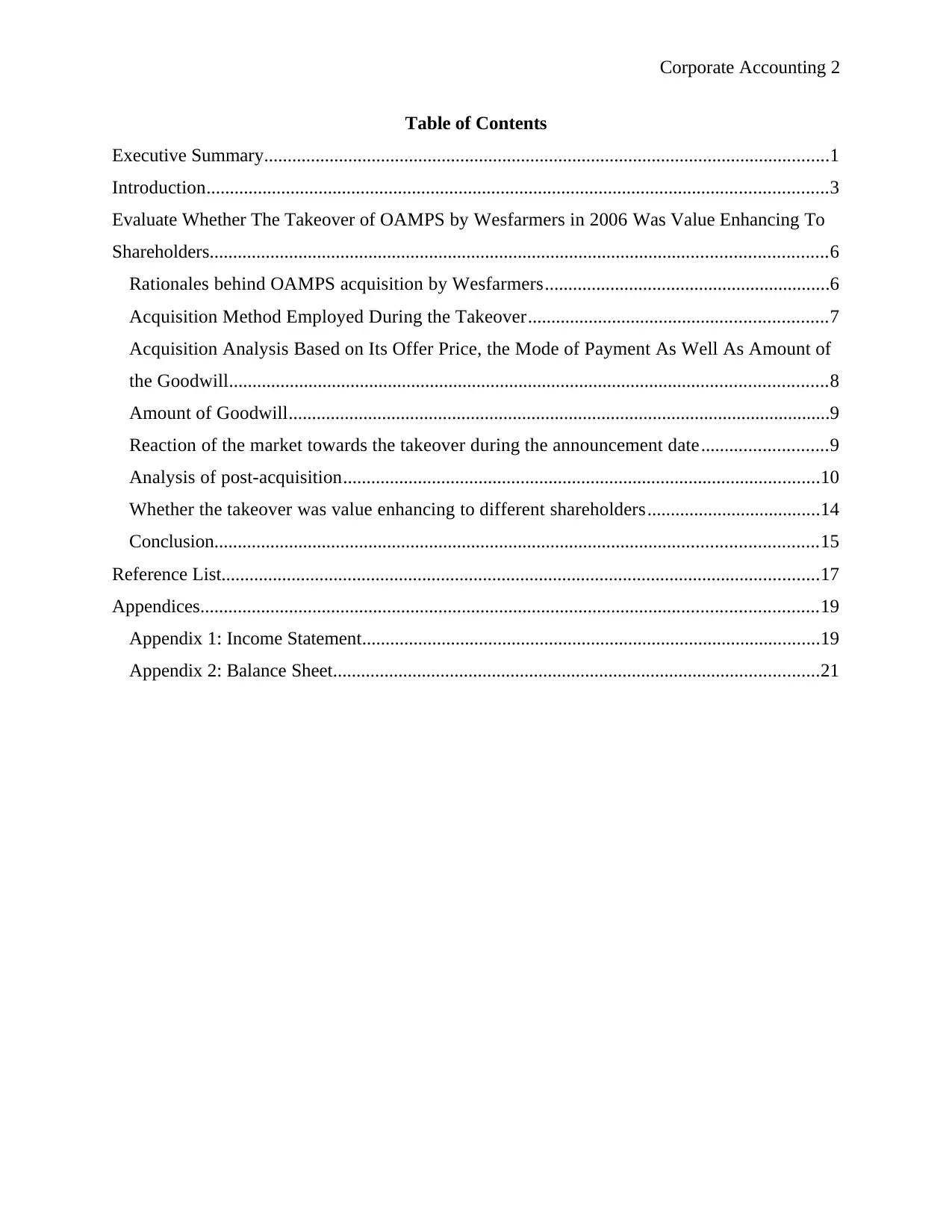
Corporate Accounting 2
Table of Contents
Executive Summary.........................................................................................................................1
Introduction.....................................................................................................................................3
Evaluate Whether The Takeover of OAMPS by Wesfarmers in 2006 Was Value Enhancing To
Shareholders....................................................................................................................................6
Rationales behind OAMPS acquisition by Wesfarmers.............................................................6
Acquisition Method Employed During the Takeover................................................................7
Acquisition Analysis Based on Its Offer Price, the Mode of Payment As Well As Amount of
the Goodwill................................................................................................................................8
Amount of Goodwill....................................................................................................................9
Reaction of the market towards the takeover during the announcement date...........................9
Analysis of post-acquisition......................................................................................................10
Whether the takeover was value enhancing to different shareholders.....................................14
Conclusion.................................................................................................................................15
Reference List................................................................................................................................17
Appendices....................................................................................................................................19
Appendix 1: Income Statement..................................................................................................19
Appendix 2: Balance Sheet........................................................................................................21
Table of Contents
Executive Summary.........................................................................................................................1
Introduction.....................................................................................................................................3
Evaluate Whether The Takeover of OAMPS by Wesfarmers in 2006 Was Value Enhancing To
Shareholders....................................................................................................................................6
Rationales behind OAMPS acquisition by Wesfarmers.............................................................6
Acquisition Method Employed During the Takeover................................................................7
Acquisition Analysis Based on Its Offer Price, the Mode of Payment As Well As Amount of
the Goodwill................................................................................................................................8
Amount of Goodwill....................................................................................................................9
Reaction of the market towards the takeover during the announcement date...........................9
Analysis of post-acquisition......................................................................................................10
Whether the takeover was value enhancing to different shareholders.....................................14
Conclusion.................................................................................................................................15
Reference List................................................................................................................................17
Appendices....................................................................................................................................19
Appendix 1: Income Statement..................................................................................................19
Appendix 2: Balance Sheet........................................................................................................21
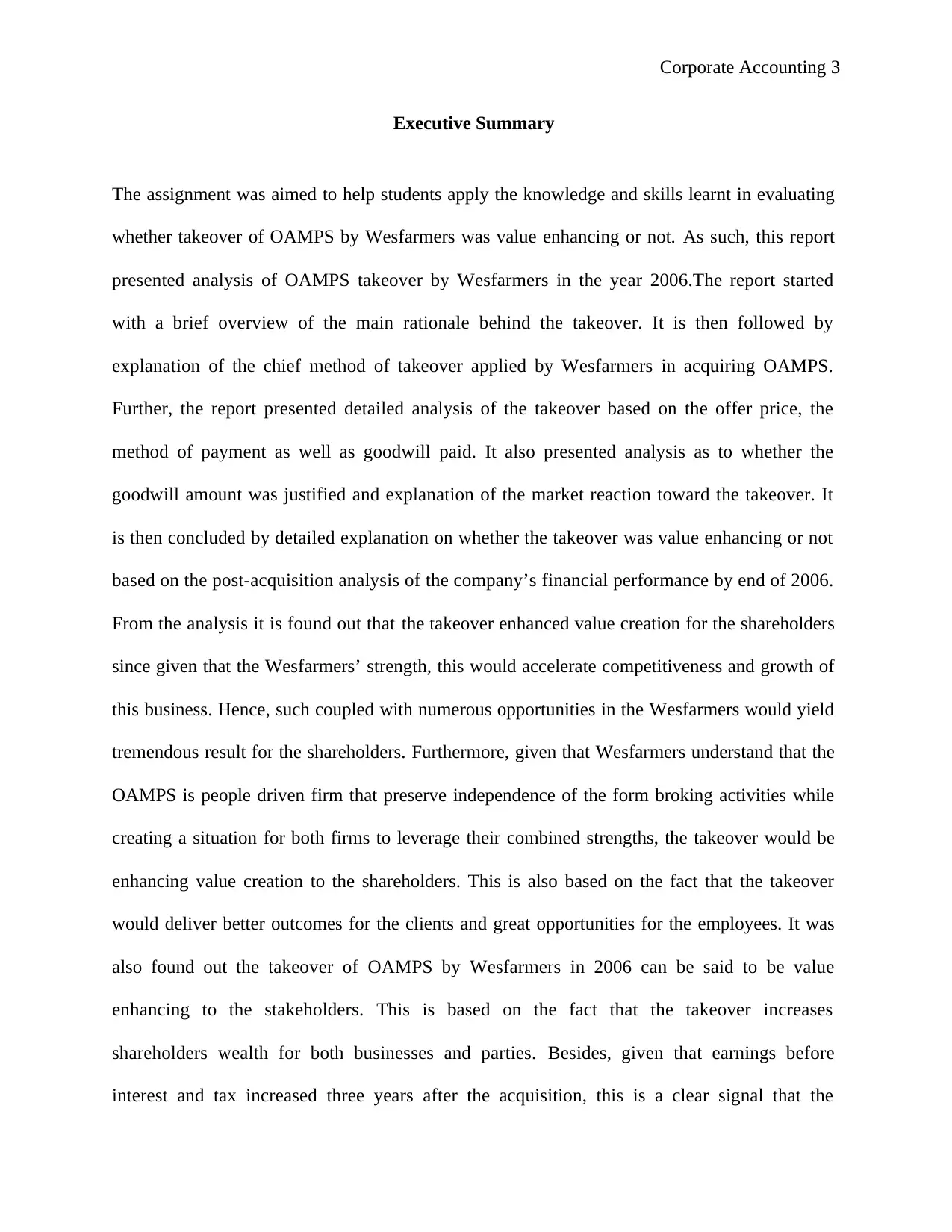
Corporate Accounting 3
Executive Summary
The assignment was aimed to help students apply the knowledge and skills learnt in evaluating
whether takeover of OAMPS by Wesfarmers was value enhancing or not. As such, this report
presented analysis of OAMPS takeover by Wesfarmers in the year 2006.The report started
with a brief overview of the main rationale behind the takeover. It is then followed by
explanation of the chief method of takeover applied by Wesfarmers in acquiring OAMPS.
Further, the report presented detailed analysis of the takeover based on the offer price, the
method of payment as well as goodwill paid. It also presented analysis as to whether the
goodwill amount was justified and explanation of the market reaction toward the takeover. It
is then concluded by detailed explanation on whether the takeover was value enhancing or not
based on the post-acquisition analysis of the company’s financial performance by end of 2006.
From the analysis it is found out that the takeover enhanced value creation for the shareholders
since given that the Wesfarmers’ strength, this would accelerate competitiveness and growth of
this business. Hence, such coupled with numerous opportunities in the Wesfarmers would yield
tremendous result for the shareholders. Furthermore, given that Wesfarmers understand that the
OAMPS is people driven firm that preserve independence of the form broking activities while
creating a situation for both firms to leverage their combined strengths, the takeover would be
enhancing value creation to the shareholders. This is also based on the fact that the takeover
would deliver better outcomes for the clients and great opportunities for the employees. It was
also found out the takeover of OAMPS by Wesfarmers in 2006 can be said to be value
enhancing to the stakeholders. This is based on the fact that the takeover increases
shareholders wealth for both businesses and parties. Besides, given that earnings before
interest and tax increased three years after the acquisition, this is a clear signal that the
Executive Summary
The assignment was aimed to help students apply the knowledge and skills learnt in evaluating
whether takeover of OAMPS by Wesfarmers was value enhancing or not. As such, this report
presented analysis of OAMPS takeover by Wesfarmers in the year 2006.The report started
with a brief overview of the main rationale behind the takeover. It is then followed by
explanation of the chief method of takeover applied by Wesfarmers in acquiring OAMPS.
Further, the report presented detailed analysis of the takeover based on the offer price, the
method of payment as well as goodwill paid. It also presented analysis as to whether the
goodwill amount was justified and explanation of the market reaction toward the takeover. It
is then concluded by detailed explanation on whether the takeover was value enhancing or not
based on the post-acquisition analysis of the company’s financial performance by end of 2006.
From the analysis it is found out that the takeover enhanced value creation for the shareholders
since given that the Wesfarmers’ strength, this would accelerate competitiveness and growth of
this business. Hence, such coupled with numerous opportunities in the Wesfarmers would yield
tremendous result for the shareholders. Furthermore, given that Wesfarmers understand that the
OAMPS is people driven firm that preserve independence of the form broking activities while
creating a situation for both firms to leverage their combined strengths, the takeover would be
enhancing value creation to the shareholders. This is also based on the fact that the takeover
would deliver better outcomes for the clients and great opportunities for the employees. It was
also found out the takeover of OAMPS by Wesfarmers in 2006 can be said to be value
enhancing to the stakeholders. This is based on the fact that the takeover increases
shareholders wealth for both businesses and parties. Besides, given that earnings before
interest and tax increased three years after the acquisition, this is a clear signal that the
⊘ This is a preview!⊘
Do you want full access?
Subscribe today to unlock all pages.

Trusted by 1+ million students worldwide
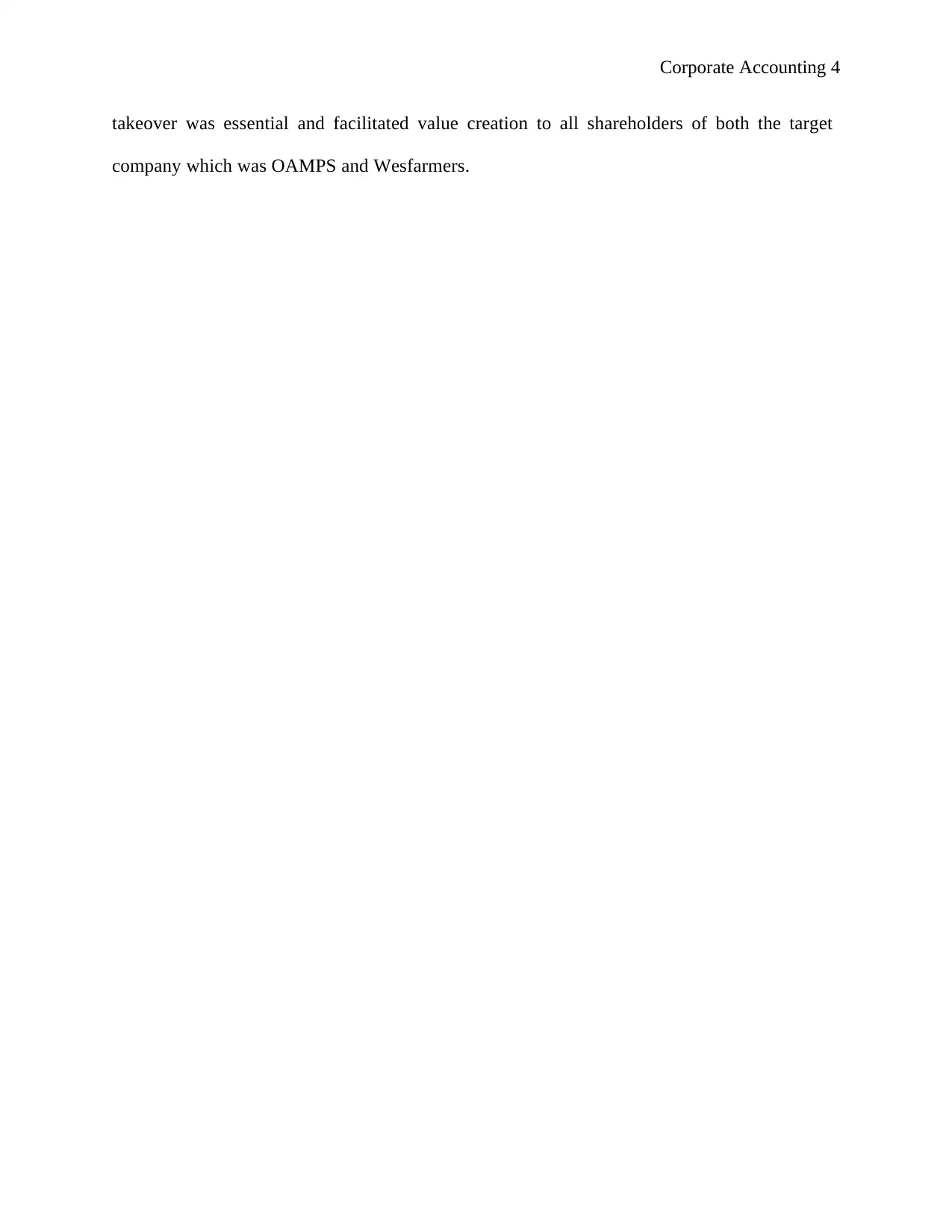
Corporate Accounting 4
takeover was essential and facilitated value creation to all shareholders of both the target
company which was OAMPS and Wesfarmers.
takeover was essential and facilitated value creation to all shareholders of both the target
company which was OAMPS and Wesfarmers.
Paraphrase This Document
Need a fresh take? Get an instant paraphrase of this document with our AI Paraphraser
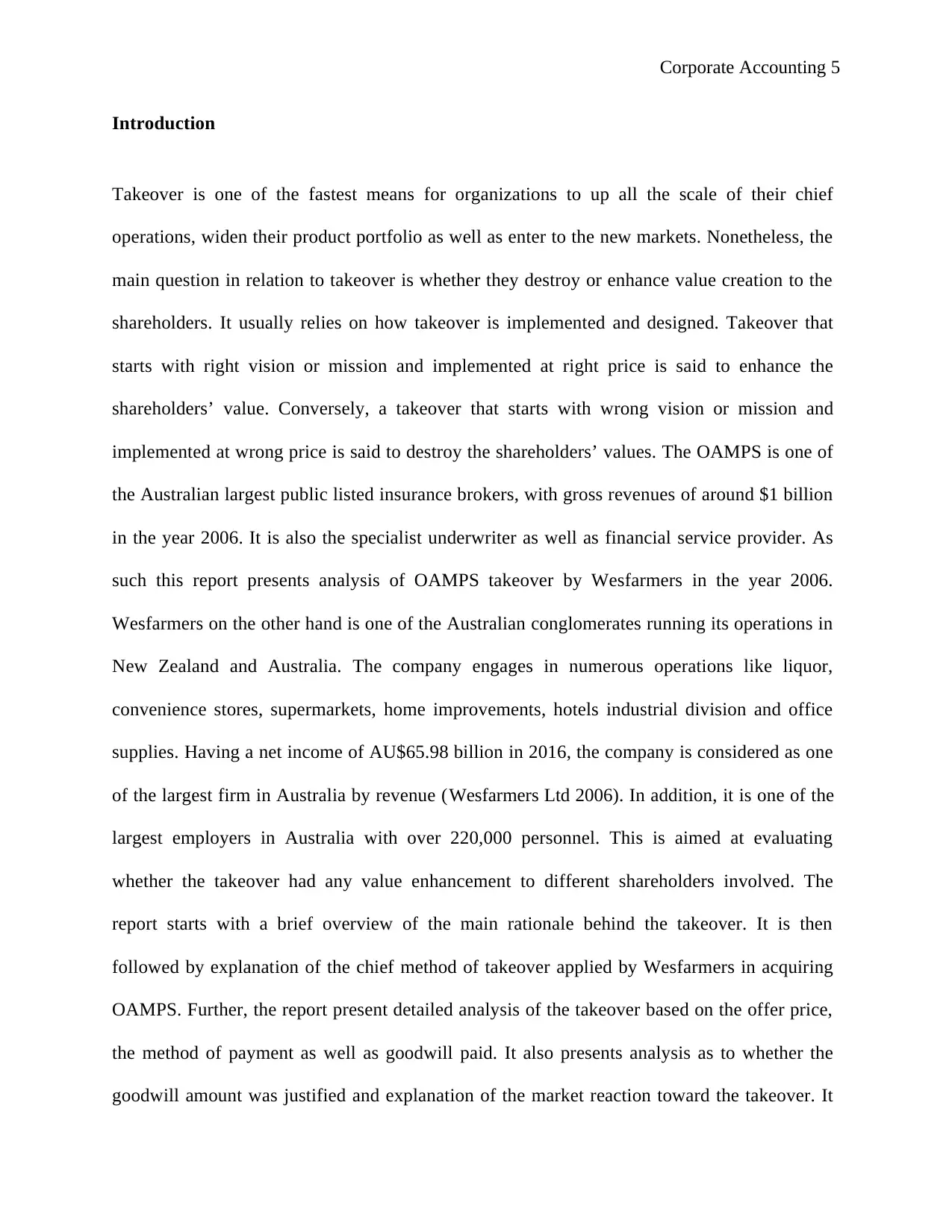
Corporate Accounting 5
Introduction
Takeover is one of the fastest means for organizations to up all the scale of their chief
operations, widen their product portfolio as well as enter to the new markets. Nonetheless, the
main question in relation to takeover is whether they destroy or enhance value creation to the
shareholders. It usually relies on how takeover is implemented and designed. Takeover that
starts with right vision or mission and implemented at right price is said to enhance the
shareholders’ value. Conversely, a takeover that starts with wrong vision or mission and
implemented at wrong price is said to destroy the shareholders’ values. The OAMPS is one of
the Australian largest public listed insurance brokers, with gross revenues of around $1 billion
in the year 2006. It is also the specialist underwriter as well as financial service provider. As
such this report presents analysis of OAMPS takeover by Wesfarmers in the year 2006.
Wesfarmers on the other hand is one of the Australian conglomerates running its operations in
New Zealand and Australia. The company engages in numerous operations like liquor,
convenience stores, supermarkets, home improvements, hotels industrial division and office
supplies. Having a net income of AU$65.98 billion in 2016, the company is considered as one
of the largest firm in Australia by revenue (Wesfarmers Ltd 2006). In addition, it is one of the
largest employers in Australia with over 220,000 personnel. This is aimed at evaluating
whether the takeover had any value enhancement to different shareholders involved. The
report starts with a brief overview of the main rationale behind the takeover. It is then
followed by explanation of the chief method of takeover applied by Wesfarmers in acquiring
OAMPS. Further, the report present detailed analysis of the takeover based on the offer price,
the method of payment as well as goodwill paid. It also presents analysis as to whether the
goodwill amount was justified and explanation of the market reaction toward the takeover. It
Introduction
Takeover is one of the fastest means for organizations to up all the scale of their chief
operations, widen their product portfolio as well as enter to the new markets. Nonetheless, the
main question in relation to takeover is whether they destroy or enhance value creation to the
shareholders. It usually relies on how takeover is implemented and designed. Takeover that
starts with right vision or mission and implemented at right price is said to enhance the
shareholders’ value. Conversely, a takeover that starts with wrong vision or mission and
implemented at wrong price is said to destroy the shareholders’ values. The OAMPS is one of
the Australian largest public listed insurance brokers, with gross revenues of around $1 billion
in the year 2006. It is also the specialist underwriter as well as financial service provider. As
such this report presents analysis of OAMPS takeover by Wesfarmers in the year 2006.
Wesfarmers on the other hand is one of the Australian conglomerates running its operations in
New Zealand and Australia. The company engages in numerous operations like liquor,
convenience stores, supermarkets, home improvements, hotels industrial division and office
supplies. Having a net income of AU$65.98 billion in 2016, the company is considered as one
of the largest firm in Australia by revenue (Wesfarmers Ltd 2006). In addition, it is one of the
largest employers in Australia with over 220,000 personnel. This is aimed at evaluating
whether the takeover had any value enhancement to different shareholders involved. The
report starts with a brief overview of the main rationale behind the takeover. It is then
followed by explanation of the chief method of takeover applied by Wesfarmers in acquiring
OAMPS. Further, the report present detailed analysis of the takeover based on the offer price,
the method of payment as well as goodwill paid. It also presents analysis as to whether the
goodwill amount was justified and explanation of the market reaction toward the takeover. It
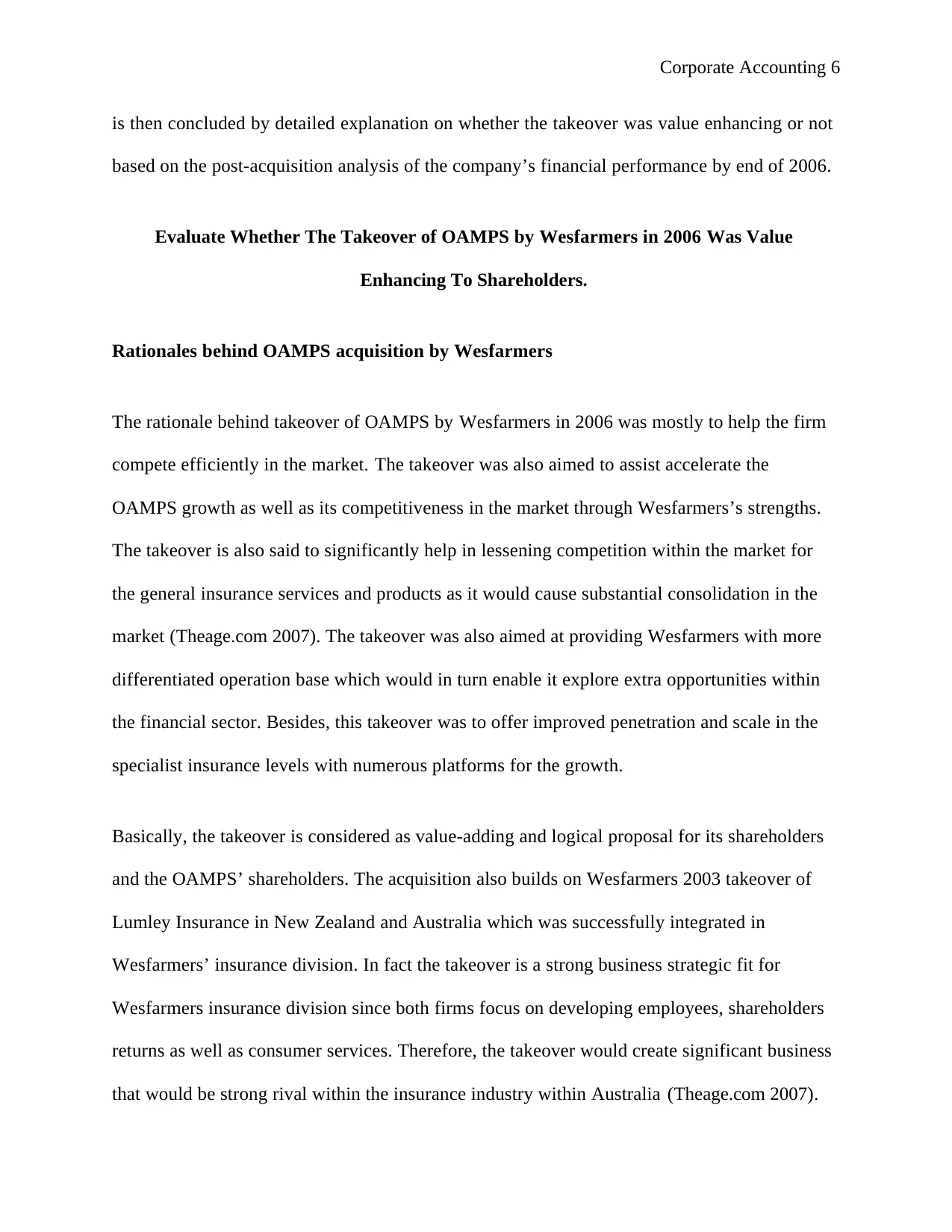
Corporate Accounting 6
is then concluded by detailed explanation on whether the takeover was value enhancing or not
based on the post-acquisition analysis of the company’s financial performance by end of 2006.
Evaluate Whether The Takeover of OAMPS by Wesfarmers in 2006 Was Value
Enhancing To Shareholders.
Rationales behind OAMPS acquisition by Wesfarmers
The rationale behind takeover of OAMPS by Wesfarmers in 2006 was mostly to help the firm
compete efficiently in the market. The takeover was also aimed to assist accelerate the
OAMPS growth as well as its competitiveness in the market through Wesfarmers’s strengths.
The takeover is also said to significantly help in lessening competition within the market for
the general insurance services and products as it would cause substantial consolidation in the
market (Theage.com 2007). The takeover was also aimed at providing Wesfarmers with more
differentiated operation base which would in turn enable it explore extra opportunities within
the financial sector. Besides, this takeover was to offer improved penetration and scale in the
specialist insurance levels with numerous platforms for the growth.
Basically, the takeover is considered as value-adding and logical proposal for its shareholders
and the OAMPS’ shareholders. The acquisition also builds on Wesfarmers 2003 takeover of
Lumley Insurance in New Zealand and Australia which was successfully integrated in
Wesfarmers’ insurance division. In fact the takeover is a strong business strategic fit for
Wesfarmers insurance division since both firms focus on developing employees, shareholders
returns as well as consumer services. Therefore, the takeover would create significant business
that would be strong rival within the insurance industry within Australia (Theage.com 2007).
is then concluded by detailed explanation on whether the takeover was value enhancing or not
based on the post-acquisition analysis of the company’s financial performance by end of 2006.
Evaluate Whether The Takeover of OAMPS by Wesfarmers in 2006 Was Value
Enhancing To Shareholders.
Rationales behind OAMPS acquisition by Wesfarmers
The rationale behind takeover of OAMPS by Wesfarmers in 2006 was mostly to help the firm
compete efficiently in the market. The takeover was also aimed to assist accelerate the
OAMPS growth as well as its competitiveness in the market through Wesfarmers’s strengths.
The takeover is also said to significantly help in lessening competition within the market for
the general insurance services and products as it would cause substantial consolidation in the
market (Theage.com 2007). The takeover was also aimed at providing Wesfarmers with more
differentiated operation base which would in turn enable it explore extra opportunities within
the financial sector. Besides, this takeover was to offer improved penetration and scale in the
specialist insurance levels with numerous platforms for the growth.
Basically, the takeover is considered as value-adding and logical proposal for its shareholders
and the OAMPS’ shareholders. The acquisition also builds on Wesfarmers 2003 takeover of
Lumley Insurance in New Zealand and Australia which was successfully integrated in
Wesfarmers’ insurance division. In fact the takeover is a strong business strategic fit for
Wesfarmers insurance division since both firms focus on developing employees, shareholders
returns as well as consumer services. Therefore, the takeover would create significant business
that would be strong rival within the insurance industry within Australia (Theage.com 2007).
⊘ This is a preview!⊘
Do you want full access?
Subscribe today to unlock all pages.

Trusted by 1+ million students worldwide
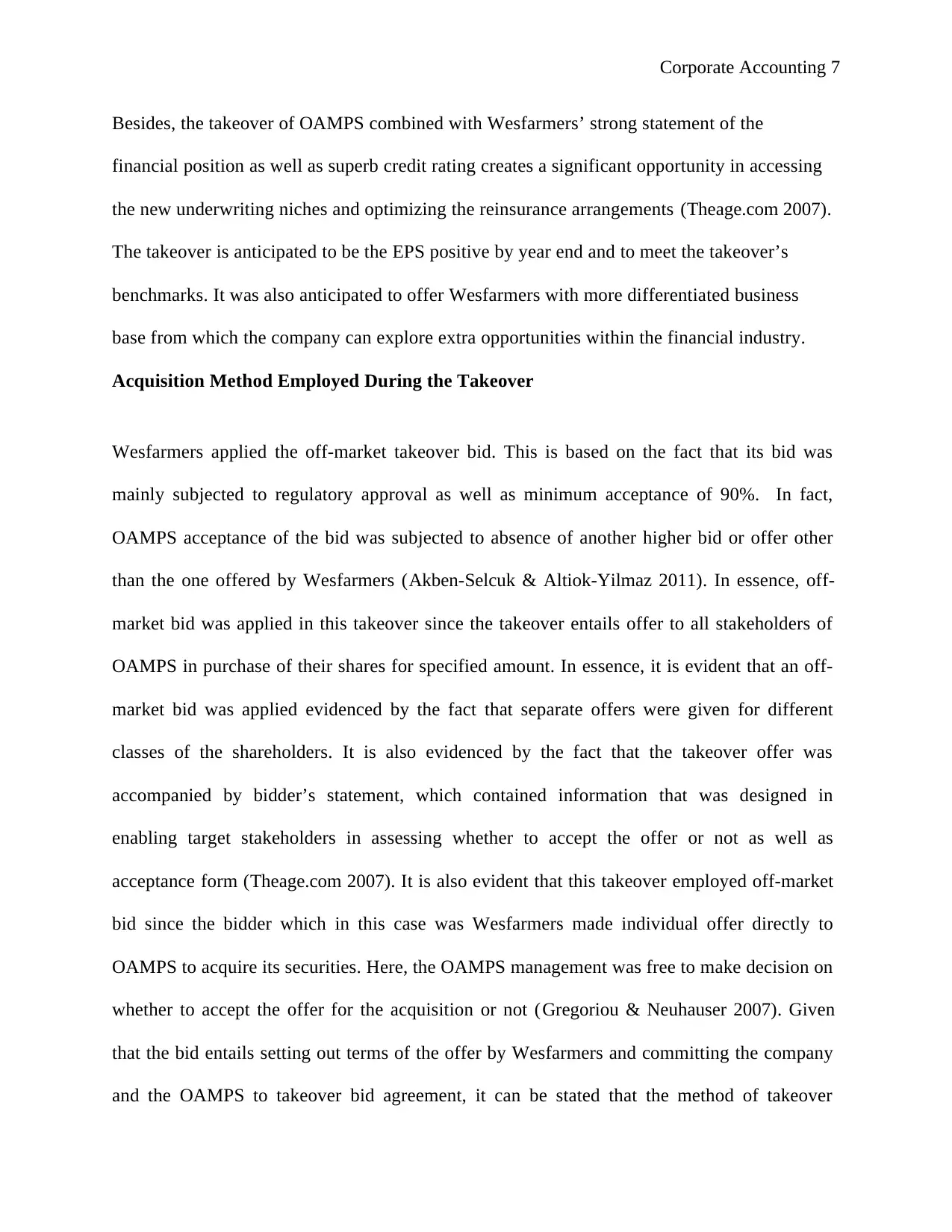
Corporate Accounting 7
Besides, the takeover of OAMPS combined with Wesfarmers’ strong statement of the
financial position as well as superb credit rating creates a significant opportunity in accessing
the new underwriting niches and optimizing the reinsurance arrangements (Theage.com 2007).
The takeover is anticipated to be the EPS positive by year end and to meet the takeover’s
benchmarks. It was also anticipated to offer Wesfarmers with more differentiated business
base from which the company can explore extra opportunities within the financial industry.
Acquisition Method Employed During the Takeover
Wesfarmers applied the off-market takeover bid. This is based on the fact that its bid was
mainly subjected to regulatory approval as well as minimum acceptance of 90%. In fact,
OAMPS acceptance of the bid was subjected to absence of another higher bid or offer other
than the one offered by Wesfarmers (Akben-Selcuk & Altiok-Yilmaz 2011). In essence, off-
market bid was applied in this takeover since the takeover entails offer to all stakeholders of
OAMPS in purchase of their shares for specified amount. In essence, it is evident that an off-
market bid was applied evidenced by the fact that separate offers were given for different
classes of the shareholders. It is also evidenced by the fact that the takeover offer was
accompanied by bidder’s statement, which contained information that was designed in
enabling target stakeholders in assessing whether to accept the offer or not as well as
acceptance form (Theage.com 2007). It is also evident that this takeover employed off-market
bid since the bidder which in this case was Wesfarmers made individual offer directly to
OAMPS to acquire its securities. Here, the OAMPS management was free to make decision on
whether to accept the offer for the acquisition or not (Gregoriou & Neuhauser 2007). Given
that the bid entails setting out terms of the offer by Wesfarmers and committing the company
and the OAMPS to takeover bid agreement, it can be stated that the method of takeover
Besides, the takeover of OAMPS combined with Wesfarmers’ strong statement of the
financial position as well as superb credit rating creates a significant opportunity in accessing
the new underwriting niches and optimizing the reinsurance arrangements (Theage.com 2007).
The takeover is anticipated to be the EPS positive by year end and to meet the takeover’s
benchmarks. It was also anticipated to offer Wesfarmers with more differentiated business
base from which the company can explore extra opportunities within the financial industry.
Acquisition Method Employed During the Takeover
Wesfarmers applied the off-market takeover bid. This is based on the fact that its bid was
mainly subjected to regulatory approval as well as minimum acceptance of 90%. In fact,
OAMPS acceptance of the bid was subjected to absence of another higher bid or offer other
than the one offered by Wesfarmers (Akben-Selcuk & Altiok-Yilmaz 2011). In essence, off-
market bid was applied in this takeover since the takeover entails offer to all stakeholders of
OAMPS in purchase of their shares for specified amount. In essence, it is evident that an off-
market bid was applied evidenced by the fact that separate offers were given for different
classes of the shareholders. It is also evidenced by the fact that the takeover offer was
accompanied by bidder’s statement, which contained information that was designed in
enabling target stakeholders in assessing whether to accept the offer or not as well as
acceptance form (Theage.com 2007). It is also evident that this takeover employed off-market
bid since the bidder which in this case was Wesfarmers made individual offer directly to
OAMPS to acquire its securities. Here, the OAMPS management was free to make decision on
whether to accept the offer for the acquisition or not (Gregoriou & Neuhauser 2007). Given
that the bid entails setting out terms of the offer by Wesfarmers and committing the company
and the OAMPS to takeover bid agreement, it can be stated that the method of takeover
Paraphrase This Document
Need a fresh take? Get an instant paraphrase of this document with our AI Paraphraser
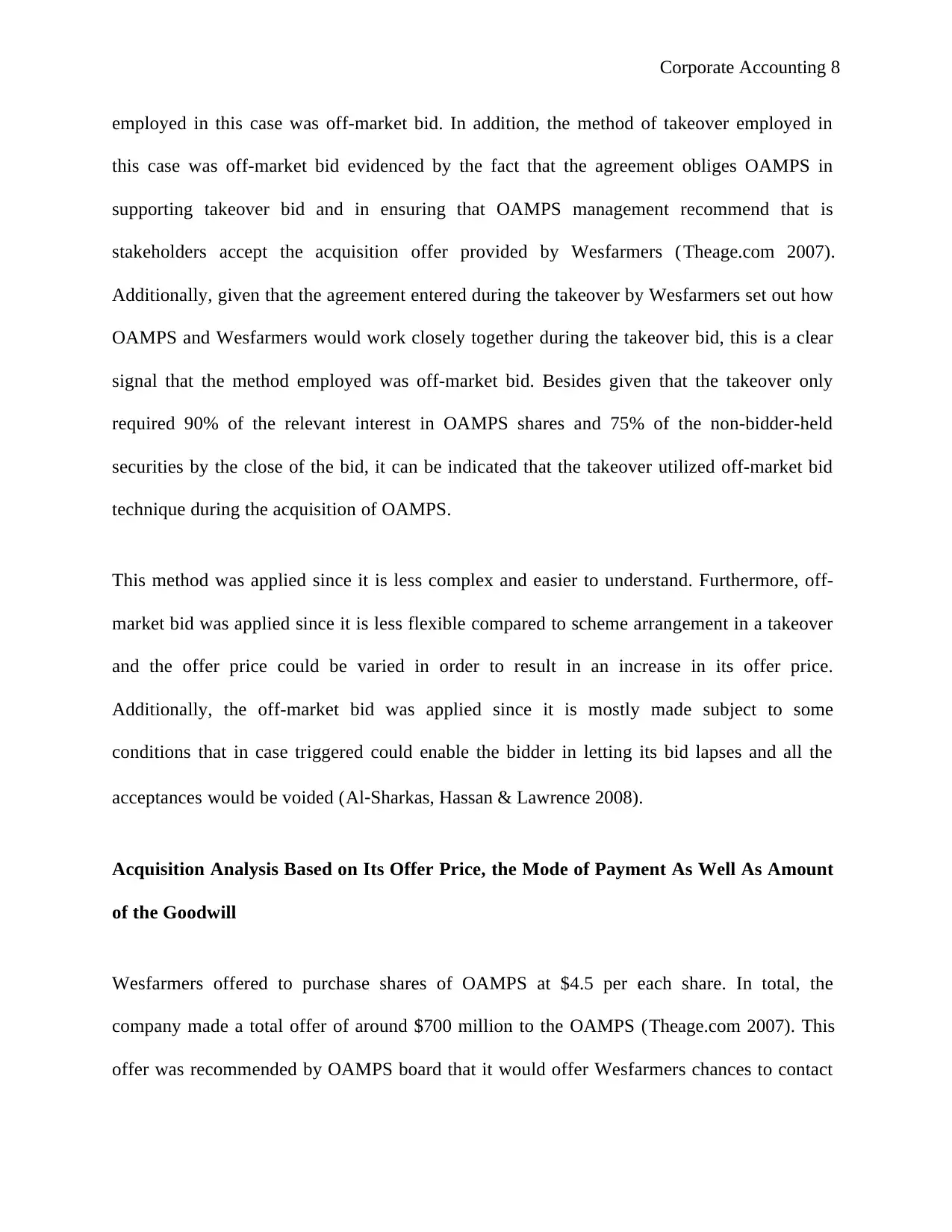
Corporate Accounting 8
employed in this case was off-market bid. In addition, the method of takeover employed in
this case was off-market bid evidenced by the fact that the agreement obliges OAMPS in
supporting takeover bid and in ensuring that OAMPS management recommend that is
stakeholders accept the acquisition offer provided by Wesfarmers ( Theage.com 2007).
Additionally, given that the agreement entered during the takeover by Wesfarmers set out how
OAMPS and Wesfarmers would work closely together during the takeover bid, this is a clear
signal that the method employed was off-market bid. Besides given that the takeover only
required 90% of the relevant interest in OAMPS shares and 75% of the non-bidder-held
securities by the close of the bid, it can be indicated that the takeover utilized off-market bid
technique during the acquisition of OAMPS.
This method was applied since it is less complex and easier to understand. Furthermore, off-
market bid was applied since it is less flexible compared to scheme arrangement in a takeover
and the offer price could be varied in order to result in an increase in its offer price.
Additionally, the off-market bid was applied since it is mostly made subject to some
conditions that in case triggered could enable the bidder in letting its bid lapses and all the
acceptances would be voided (Al‐Sharkas, Hassan & Lawrence 2008).
Acquisition Analysis Based on Its Offer Price, the Mode of Payment As Well As Amount
of the Goodwill
Wesfarmers offered to purchase shares of OAMPS at $4.5 per each share. In total, the
company made a total offer of around $700 million to the OAMPS (Theage.com 2007). This
offer was recommended by OAMPS board that it would offer Wesfarmers chances to contact
employed in this case was off-market bid. In addition, the method of takeover employed in
this case was off-market bid evidenced by the fact that the agreement obliges OAMPS in
supporting takeover bid and in ensuring that OAMPS management recommend that is
stakeholders accept the acquisition offer provided by Wesfarmers ( Theage.com 2007).
Additionally, given that the agreement entered during the takeover by Wesfarmers set out how
OAMPS and Wesfarmers would work closely together during the takeover bid, this is a clear
signal that the method employed was off-market bid. Besides given that the takeover only
required 90% of the relevant interest in OAMPS shares and 75% of the non-bidder-held
securities by the close of the bid, it can be indicated that the takeover utilized off-market bid
technique during the acquisition of OAMPS.
This method was applied since it is less complex and easier to understand. Furthermore, off-
market bid was applied since it is less flexible compared to scheme arrangement in a takeover
and the offer price could be varied in order to result in an increase in its offer price.
Additionally, the off-market bid was applied since it is mostly made subject to some
conditions that in case triggered could enable the bidder in letting its bid lapses and all the
acceptances would be voided (Al‐Sharkas, Hassan & Lawrence 2008).
Acquisition Analysis Based on Its Offer Price, the Mode of Payment As Well As Amount
of the Goodwill
Wesfarmers offered to purchase shares of OAMPS at $4.5 per each share. In total, the
company made a total offer of around $700 million to the OAMPS (Theage.com 2007). This
offer was recommended by OAMPS board that it would offer Wesfarmers chances to contact
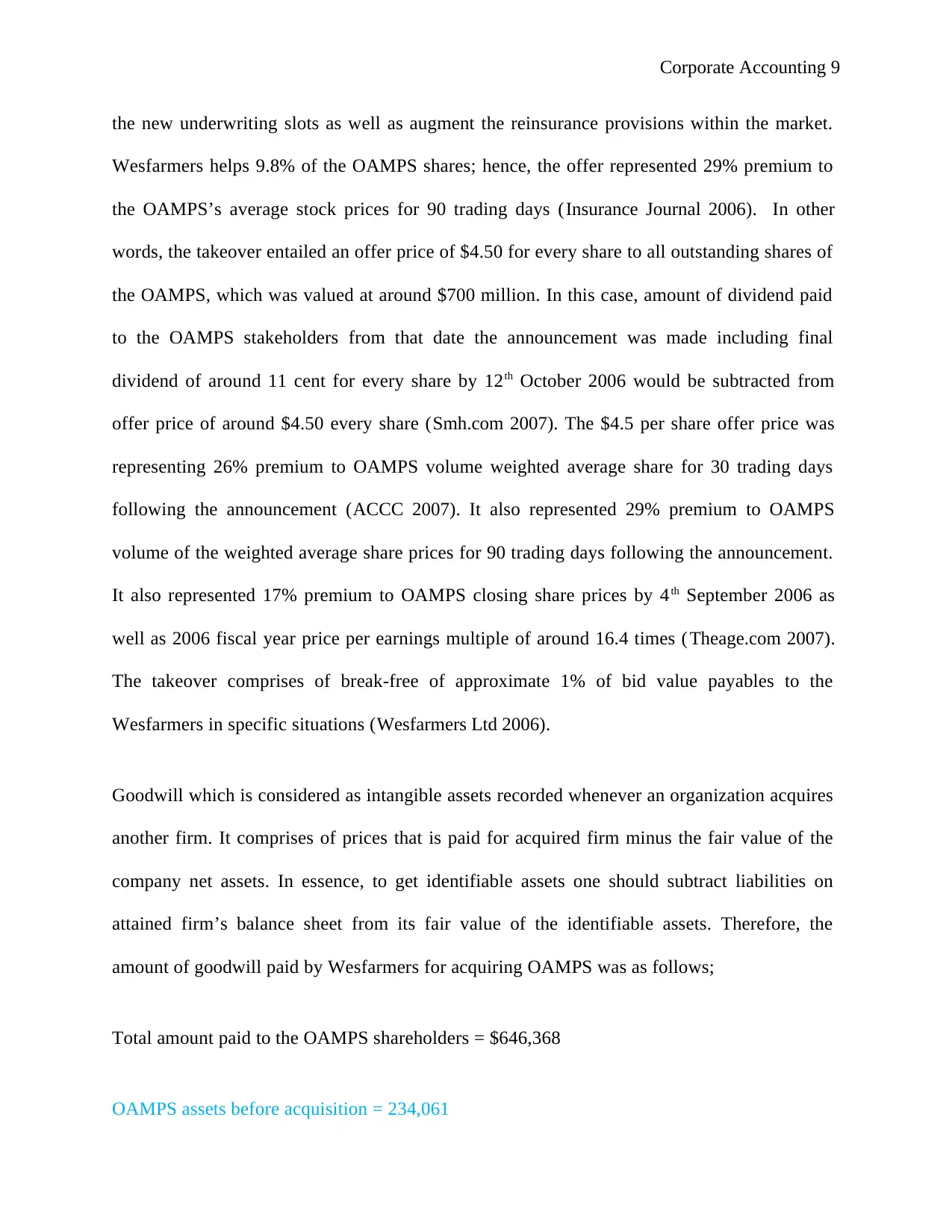
Corporate Accounting 9
the new underwriting slots as well as augment the reinsurance provisions within the market.
Wesfarmers helps 9.8% of the OAMPS shares; hence, the offer represented 29% premium to
the OAMPS’s average stock prices for 90 trading days (Insurance Journal 2006). In other
words, the takeover entailed an offer price of $4.50 for every share to all outstanding shares of
the OAMPS, which was valued at around $700 million. In this case, amount of dividend paid
to the OAMPS stakeholders from that date the announcement was made including final
dividend of around 11 cent for every share by 12th October 2006 would be subtracted from
offer price of around $4.50 every share (Smh.com 2007). The $4.5 per share offer price was
representing 26% premium to OAMPS volume weighted average share for 30 trading days
following the announcement (ACCC 2007). It also represented 29% premium to OAMPS
volume of the weighted average share prices for 90 trading days following the announcement.
It also represented 17% premium to OAMPS closing share prices by 4th September 2006 as
well as 2006 fiscal year price per earnings multiple of around 16.4 times (Theage.com 2007).
The takeover comprises of break-free of approximate 1% of bid value payables to the
Wesfarmers in specific situations (Wesfarmers Ltd 2006).
Goodwill which is considered as intangible assets recorded whenever an organization acquires
another firm. It comprises of prices that is paid for acquired firm minus the fair value of the
company net assets. In essence, to get identifiable assets one should subtract liabilities on
attained firm’s balance sheet from its fair value of the identifiable assets. Therefore, the
amount of goodwill paid by Wesfarmers for acquiring OAMPS was as follows;
Total amount paid to the OAMPS shareholders = $646,368
OAMPS assets before acquisition = 234,061
the new underwriting slots as well as augment the reinsurance provisions within the market.
Wesfarmers helps 9.8% of the OAMPS shares; hence, the offer represented 29% premium to
the OAMPS’s average stock prices for 90 trading days (Insurance Journal 2006). In other
words, the takeover entailed an offer price of $4.50 for every share to all outstanding shares of
the OAMPS, which was valued at around $700 million. In this case, amount of dividend paid
to the OAMPS stakeholders from that date the announcement was made including final
dividend of around 11 cent for every share by 12th October 2006 would be subtracted from
offer price of around $4.50 every share (Smh.com 2007). The $4.5 per share offer price was
representing 26% premium to OAMPS volume weighted average share for 30 trading days
following the announcement (ACCC 2007). It also represented 29% premium to OAMPS
volume of the weighted average share prices for 90 trading days following the announcement.
It also represented 17% premium to OAMPS closing share prices by 4th September 2006 as
well as 2006 fiscal year price per earnings multiple of around 16.4 times (Theage.com 2007).
The takeover comprises of break-free of approximate 1% of bid value payables to the
Wesfarmers in specific situations (Wesfarmers Ltd 2006).
Goodwill which is considered as intangible assets recorded whenever an organization acquires
another firm. It comprises of prices that is paid for acquired firm minus the fair value of the
company net assets. In essence, to get identifiable assets one should subtract liabilities on
attained firm’s balance sheet from its fair value of the identifiable assets. Therefore, the
amount of goodwill paid by Wesfarmers for acquiring OAMPS was as follows;
Total amount paid to the OAMPS shareholders = $646,368
OAMPS assets before acquisition = 234,061
⊘ This is a preview!⊘
Do you want full access?
Subscribe today to unlock all pages.

Trusted by 1+ million students worldwide
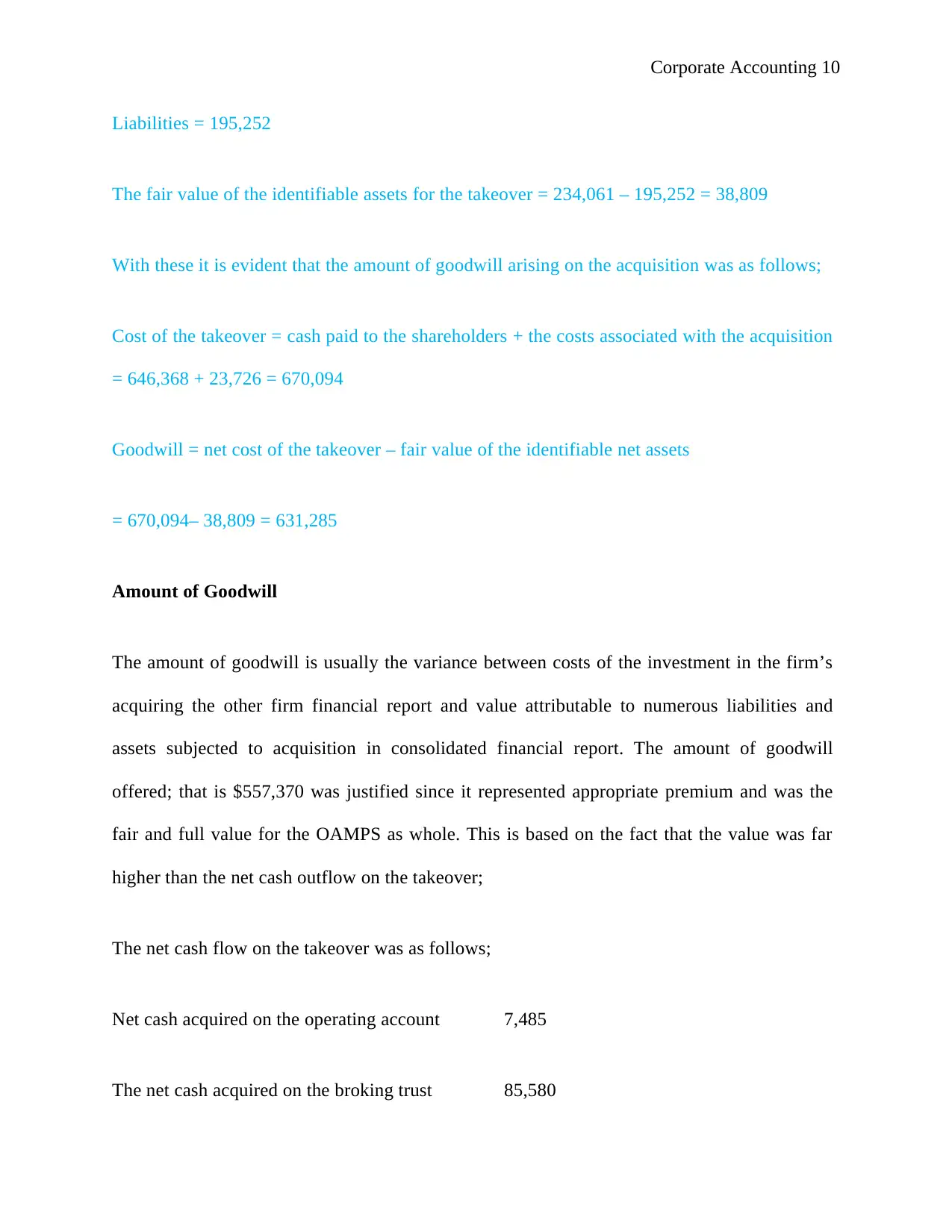
Corporate Accounting 10
Liabilities = 195,252
The fair value of the identifiable assets for the takeover = 234,061 – 195,252 = 38,809
With these it is evident that the amount of goodwill arising on the acquisition was as follows;
Cost of the takeover = cash paid to the shareholders + the costs associated with the acquisition
= 646,368 + 23,726 = 670,094
Goodwill = net cost of the takeover – fair value of the identifiable net assets
= 670,094– 38,809 = 631,285
Amount of Goodwill
The amount of goodwill is usually the variance between costs of the investment in the firm’s
acquiring the other firm financial report and value attributable to numerous liabilities and
assets subjected to acquisition in consolidated financial report. The amount of goodwill
offered; that is $557,370 was justified since it represented appropriate premium and was the
fair and full value for the OAMPS as whole. This is based on the fact that the value was far
higher than the net cash outflow on the takeover;
The net cash flow on the takeover was as follows;
Net cash acquired on the operating account 7,485
The net cash acquired on the broking trust 85,580
Liabilities = 195,252
The fair value of the identifiable assets for the takeover = 234,061 – 195,252 = 38,809
With these it is evident that the amount of goodwill arising on the acquisition was as follows;
Cost of the takeover = cash paid to the shareholders + the costs associated with the acquisition
= 646,368 + 23,726 = 670,094
Goodwill = net cost of the takeover – fair value of the identifiable net assets
= 670,094– 38,809 = 631,285
Amount of Goodwill
The amount of goodwill is usually the variance between costs of the investment in the firm’s
acquiring the other firm financial report and value attributable to numerous liabilities and
assets subjected to acquisition in consolidated financial report. The amount of goodwill
offered; that is $557,370 was justified since it represented appropriate premium and was the
fair and full value for the OAMPS as whole. This is based on the fact that the value was far
higher than the net cash outflow on the takeover;
The net cash flow on the takeover was as follows;
Net cash acquired on the operating account 7,485
The net cash acquired on the broking trust 85,580
Paraphrase This Document
Need a fresh take? Get an instant paraphrase of this document with our AI Paraphraser
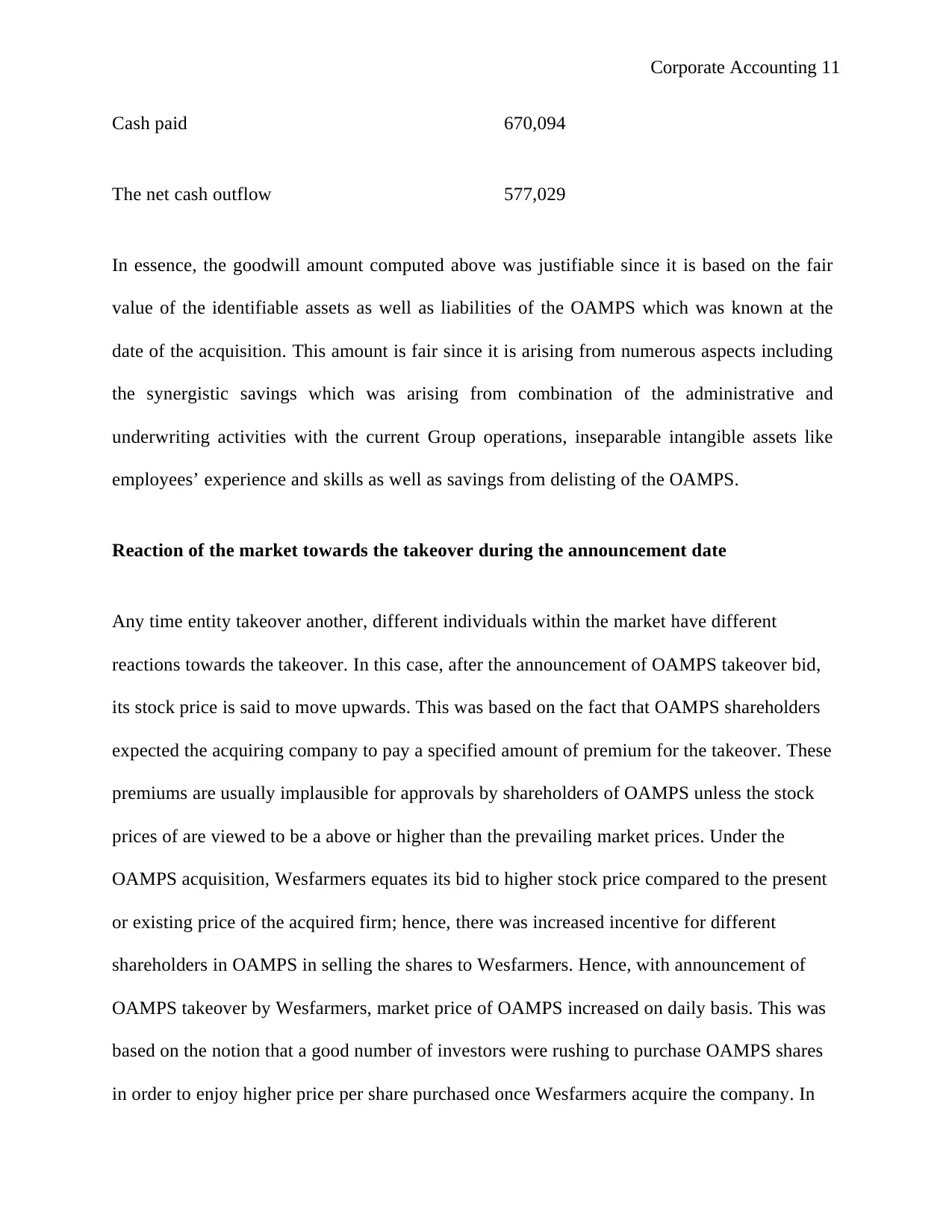
Corporate Accounting 11
Cash paid 670,094
The net cash outflow 577,029
In essence, the goodwill amount computed above was justifiable since it is based on the fair
value of the identifiable assets as well as liabilities of the OAMPS which was known at the
date of the acquisition. This amount is fair since it is arising from numerous aspects including
the synergistic savings which was arising from combination of the administrative and
underwriting activities with the current Group operations, inseparable intangible assets like
employees’ experience and skills as well as savings from delisting of the OAMPS.
Reaction of the market towards the takeover during the announcement date
Any time entity takeover another, different individuals within the market have different
reactions towards the takeover. In this case, after the announcement of OAMPS takeover bid,
its stock price is said to move upwards. This was based on the fact that OAMPS shareholders
expected the acquiring company to pay a specified amount of premium for the takeover. These
premiums are usually implausible for approvals by shareholders of OAMPS unless the stock
prices of are viewed to be a above or higher than the prevailing market prices. Under the
OAMPS acquisition, Wesfarmers equates its bid to higher stock price compared to the present
or existing price of the acquired firm; hence, there was increased incentive for different
shareholders in OAMPS in selling the shares to Wesfarmers. Hence, with announcement of
OAMPS takeover by Wesfarmers, market price of OAMPS increased on daily basis. This was
based on the notion that a good number of investors were rushing to purchase OAMPS shares
in order to enjoy higher price per share purchased once Wesfarmers acquire the company. In
Cash paid 670,094
The net cash outflow 577,029
In essence, the goodwill amount computed above was justifiable since it is based on the fair
value of the identifiable assets as well as liabilities of the OAMPS which was known at the
date of the acquisition. This amount is fair since it is arising from numerous aspects including
the synergistic savings which was arising from combination of the administrative and
underwriting activities with the current Group operations, inseparable intangible assets like
employees’ experience and skills as well as savings from delisting of the OAMPS.
Reaction of the market towards the takeover during the announcement date
Any time entity takeover another, different individuals within the market have different
reactions towards the takeover. In this case, after the announcement of OAMPS takeover bid,
its stock price is said to move upwards. This was based on the fact that OAMPS shareholders
expected the acquiring company to pay a specified amount of premium for the takeover. These
premiums are usually implausible for approvals by shareholders of OAMPS unless the stock
prices of are viewed to be a above or higher than the prevailing market prices. Under the
OAMPS acquisition, Wesfarmers equates its bid to higher stock price compared to the present
or existing price of the acquired firm; hence, there was increased incentive for different
shareholders in OAMPS in selling the shares to Wesfarmers. Hence, with announcement of
OAMPS takeover by Wesfarmers, market price of OAMPS increased on daily basis. This was
based on the notion that a good number of investors were rushing to purchase OAMPS shares
in order to enjoy higher price per share purchased once Wesfarmers acquire the company. In
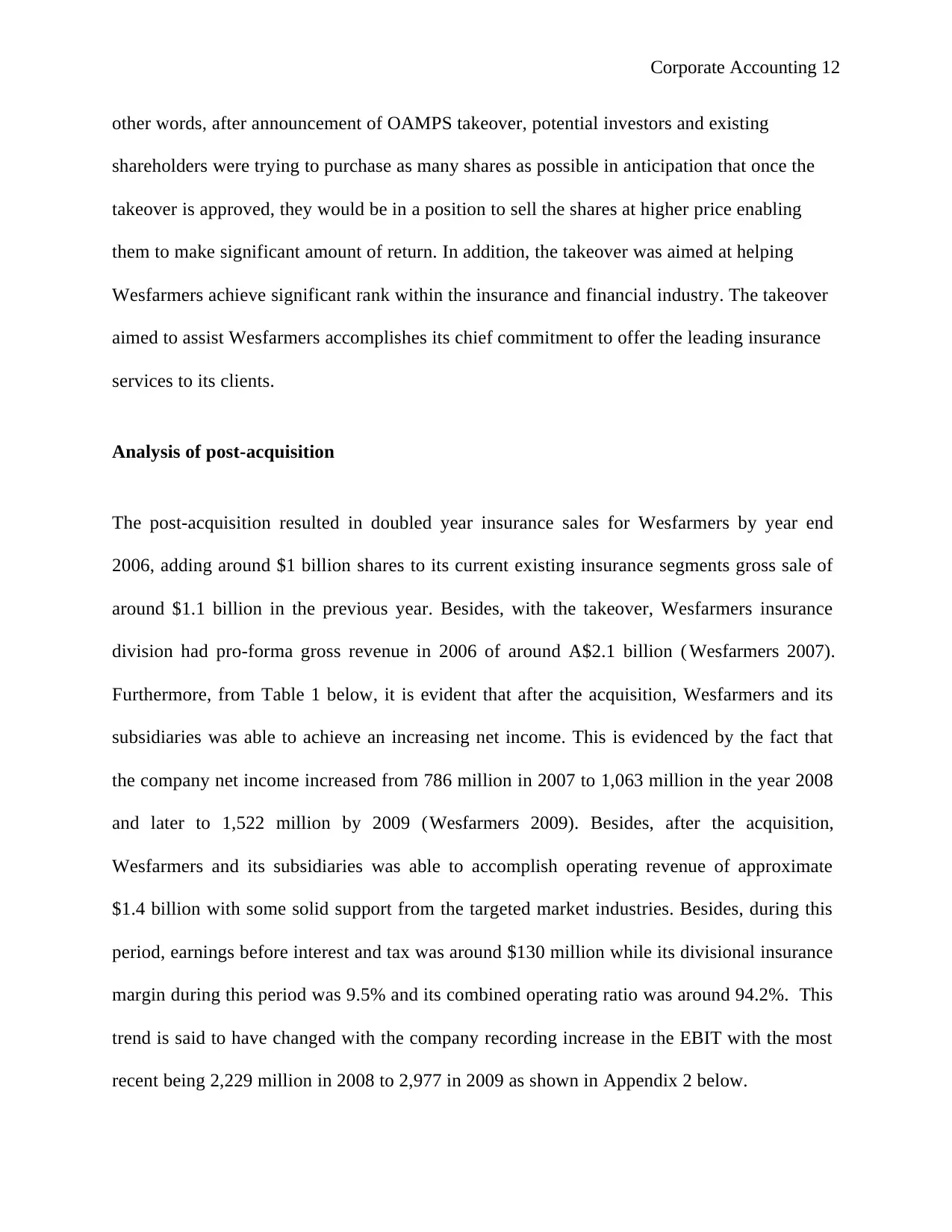
Corporate Accounting 12
other words, after announcement of OAMPS takeover, potential investors and existing
shareholders were trying to purchase as many shares as possible in anticipation that once the
takeover is approved, they would be in a position to sell the shares at higher price enabling
them to make significant amount of return. In addition, the takeover was aimed at helping
Wesfarmers achieve significant rank within the insurance and financial industry. The takeover
aimed to assist Wesfarmers accomplishes its chief commitment to offer the leading insurance
services to its clients.
Analysis of post-acquisition
The post-acquisition resulted in doubled year insurance sales for Wesfarmers by year end
2006, adding around $1 billion shares to its current existing insurance segments gross sale of
around $1.1 billion in the previous year. Besides, with the takeover, Wesfarmers insurance
division had pro-forma gross revenue in 2006 of around A$2.1 billion ( Wesfarmers 2007).
Furthermore, from Table 1 below, it is evident that after the acquisition, Wesfarmers and its
subsidiaries was able to achieve an increasing net income. This is evidenced by the fact that
the company net income increased from 786 million in 2007 to 1,063 million in the year 2008
and later to 1,522 million by 2009 (Wesfarmers 2009). Besides, after the acquisition,
Wesfarmers and its subsidiaries was able to accomplish operating revenue of approximate
$1.4 billion with some solid support from the targeted market industries. Besides, during this
period, earnings before interest and tax was around $130 million while its divisional insurance
margin during this period was 9.5% and its combined operating ratio was around 94.2%. This
trend is said to have changed with the company recording increase in the EBIT with the most
recent being 2,229 million in 2008 to 2,977 in 2009 as shown in Appendix 2 below.
other words, after announcement of OAMPS takeover, potential investors and existing
shareholders were trying to purchase as many shares as possible in anticipation that once the
takeover is approved, they would be in a position to sell the shares at higher price enabling
them to make significant amount of return. In addition, the takeover was aimed at helping
Wesfarmers achieve significant rank within the insurance and financial industry. The takeover
aimed to assist Wesfarmers accomplishes its chief commitment to offer the leading insurance
services to its clients.
Analysis of post-acquisition
The post-acquisition resulted in doubled year insurance sales for Wesfarmers by year end
2006, adding around $1 billion shares to its current existing insurance segments gross sale of
around $1.1 billion in the previous year. Besides, with the takeover, Wesfarmers insurance
division had pro-forma gross revenue in 2006 of around A$2.1 billion ( Wesfarmers 2007).
Furthermore, from Table 1 below, it is evident that after the acquisition, Wesfarmers and its
subsidiaries was able to achieve an increasing net income. This is evidenced by the fact that
the company net income increased from 786 million in 2007 to 1,063 million in the year 2008
and later to 1,522 million by 2009 (Wesfarmers 2009). Besides, after the acquisition,
Wesfarmers and its subsidiaries was able to accomplish operating revenue of approximate
$1.4 billion with some solid support from the targeted market industries. Besides, during this
period, earnings before interest and tax was around $130 million while its divisional insurance
margin during this period was 9.5% and its combined operating ratio was around 94.2%. This
trend is said to have changed with the company recording increase in the EBIT with the most
recent being 2,229 million in 2008 to 2,977 in 2009 as shown in Appendix 2 below.
⊘ This is a preview!⊘
Do you want full access?
Subscribe today to unlock all pages.

Trusted by 1+ million students worldwide
1 out of 24
Related Documents
Your All-in-One AI-Powered Toolkit for Academic Success.
+13062052269
info@desklib.com
Available 24*7 on WhatsApp / Email
![[object Object]](/_next/static/media/star-bottom.7253800d.svg)
Unlock your academic potential
Copyright © 2020–2025 A2Z Services. All Rights Reserved. Developed and managed by ZUCOL.




